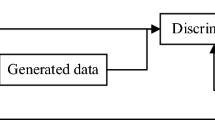Abstract
Recently, the generative adversarial networks(GAN) has been widely used in various fields of machine learning. It avoids the complicated solving process of the original generation model while ensuring the generation effect. However, since the inputs of GAN are random initialized, it takes a long time to train the data generated by the model to fit the original data distribution. Therefore, in this paper, we propose a principal component analysis optimized generative adversarial networks (PCA-GAN). The original data is compressed and reduced by principal component analysis to generate the input of the confrontation network, so that the input data retains the characteristics of the original data to some extent, thereby improving the data generation performance and reducing the training time cost. We applied our PCA-GAN to image classification, and the experimental results show that the model effectively improve the accuracy of image classification and enhance the stability of the model.












Similar content being viewed by others
References
Abdi H, Williams L J (2010) Principal component analysis. Wiley Interdiscip Rev Comput Stat 2(4): 433–459
Arjovsky M, Chintala S, Bottou L (2017) Wasserstein GAN
Denton E, Chintala S, Szlam A et al (2015) Deep generative image models using a Laplacian pyramid of adversarial networks. NIPS 47:56–72
Denton E, Gross S, Fergus R (2016) Semi-supervised learning with context-conditional generative adversarial networks. Comput Sci 25:89–105
Goodfellow I J, Pouget-Abadie J, Mirza M, et al. (2014) Generative adversarial networks. In: Advances in neural information processing systems, vol 3, pp 2672–2680
Kumar A, Sattigeri P, Fletcher PT (2017) Improved semi-supervised learning with GANs using manifold invariances. NIPS 12:64–88
Li C, Xu T, Zhu J, Zhang B (2017) Triple generative adversarial nets Guyon I, Luxburg U V, Bengio S, Wallach H, Fergus R, Vishwanathan S, Garnett R (eds), vol 30, Curran Associates, Inc.
Makhzani A, Shlens J, Jaitly N, et al. (2015) Adversarial autoencoders. Comput Sci 12:93–101
Qi G J (2017) Loss-sensitive generative adversarial networks on Lipschitz densities. International journal of computer vision. https://doi.org/10.1007/s11263-019-01265-2
Qi GJ, Zhang L, Hu H, Edraki M, Wang J, Hua XS (2018) Global versus localized generative adversarial nets. In: Proceedings of the IEEE conference on computer vision and pattern recognition, pp 1517–1525
Radford A, Metz L, Chintala S (2015) Unsupervised representation learning with deep convolutional generative adversarial networks computer science. NIPS 32:345–362
Rosca M, Lakshminarayanan B, Warde-Farley D et al (2017) Variational approaches for auto-encoding generative adversarial networks. NIPS 79–92
Salimans T, Goodfellow I, Zaremba W et al (2016) Improved techniques for training GANs. In: Proceedings of NIPS
Salimans T, Goodfellow I, Zaremba W, Cheung V, Radford A, Chen X, Chen X (2016) Improved techniques for training gans. In: Lee D D, Sugiyama M, Luxburg U V, Guyon I, Garnett R (eds) Advances in neural information processing systems, vol 29. Curran Associates Inc., pp 2234–2242
Springenberg J T (2015) Unsupervised and semi-supervised learning with categorical generative adversarial networks computer science. Comput Sci 9:34–50
Song L, Wang C, Zhang L, Du B, Zhang Q, Huang C, Wang X (2020) Unsupervised domain adaptive re-identification: Theory and Practice. Pattern Recognit 102:1–11
Wang N, Ma S, Li J, Zhang Y, Zhang L (2020) Multistage attention network for image inpainting. Pattern Recognit 106:1–12
Zhang S, He F (2020) DRCDN: learning deep residual convolutional dehazing networks. Vis Comput online. https://doi.org/10.1007/s00371-019-01774-8
Zhang S, He F, Ren W (2020) NLDN: non-local dehazing network for dense haze removal. Neurocomputing 410:363–373
Zhao J, Mathieu M, Lecun Y (2016) Energy-based generative adversarial network. Neurocomputing 20:246–256
Acknowledgements
This work is funded by the National Natural Science Foundation of China under Grant No.61772180, Technological innovation project of Hubei Province 2019(2019AAA047), Green Industry Science and Technology Leadership Program of Hubei University of Technology(No.CPYF2018005) and Hubei province graduate education innovation plan.
Author information
Authors and Affiliations
Corresponding author
Additional information
Publisher’s note
Springer Nature remains neutral with regard to jurisdictional claims in published maps and institutional affiliations.
Rights and permissions
About this article
Cite this article
Wang, C., Wu, P., Yan, L. et al. Image classification based on principal component analysis optimized generative adversarial networks. Multimed Tools Appl 80, 9687–9701 (2021). https://doi.org/10.1007/s11042-020-10137-8
Received:
Revised:
Accepted:
Published:
Issue Date:
DOI: https://doi.org/10.1007/s11042-020-10137-8




